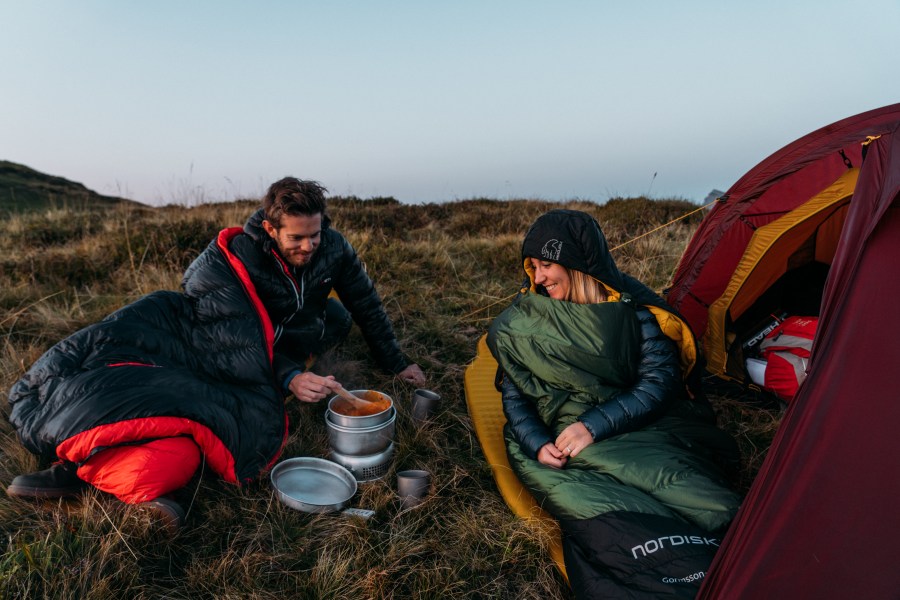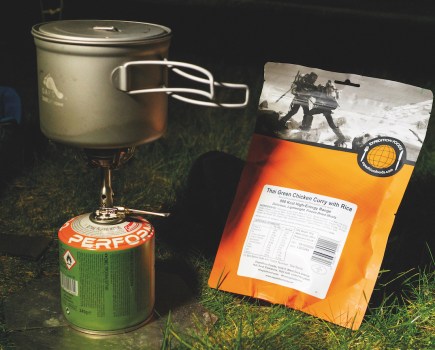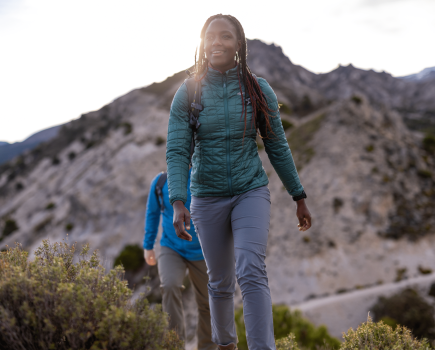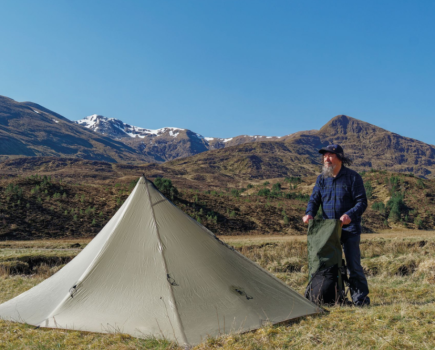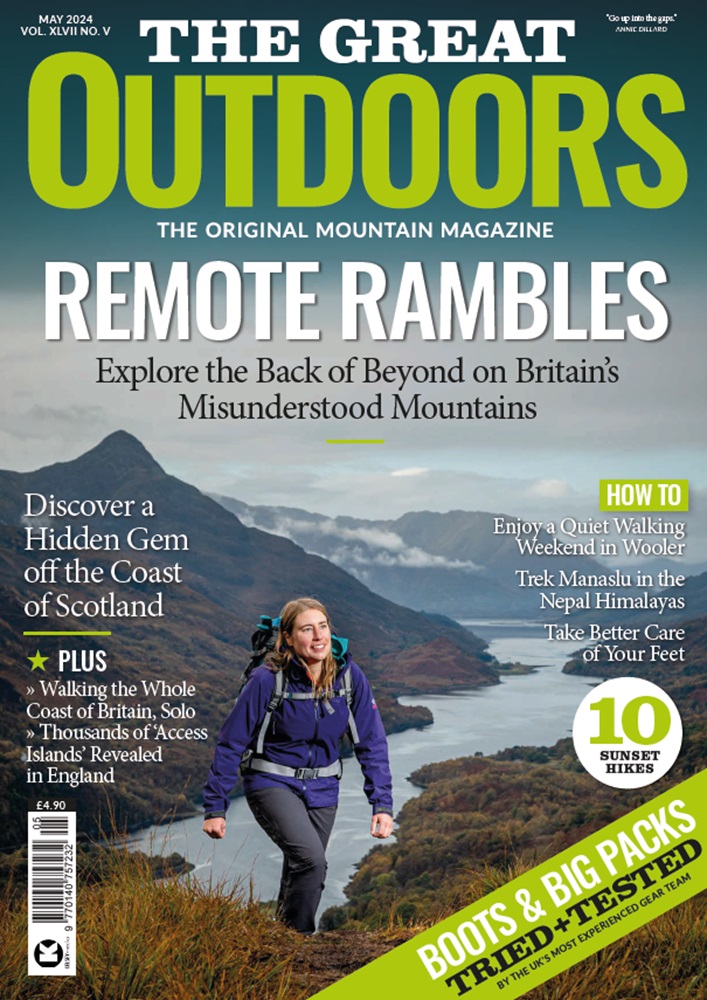During the spring, summer, and fall seasons, a sleeping bag is intended to keep you warm and comfortable. The most effective sleeping bags are typically rated for temperatures between 20 and 40 degrees Fahrenheit (-6 to 4 degrees Celsius), and they are made to be used in moderately cold or warm weather, these are called three-season bags.
As well as considering the outside night-time temperature on a camping trip, it’s important to take into account your personal comfort levels. We’re all different and some of us are ‘cold sleepers’.
Women are more likely than men to sleep colder at night, largely explained by physiological differences, including, on average, lower muscle mass. Hormonal fluctuations will also affect women’s core body temperature at different times of the month and through the menopause.
Age makes a difference, too. Both men and women are likely to suffer a decrease in the body’s circulation capacity as we age, as the walls of our blood vessels lose their elasticity. When blood moves more slowly through the body, our extremities tend to feel the cold more quickly.
So, it’s worth paying close attention to the lower end temperature ratings – sometimes called the ‘comfort limit’ – as a rough guide to temperature performance. Look for zoned areas of warmth, too – in particular the foot box, hips, and hoods with baffles around the shoulder, neck and face.
In this comparative test of the best sleeping bags on the market right now we look at everything to make sure that you have the most informed decision possible when purchasing your next sleeping bag.
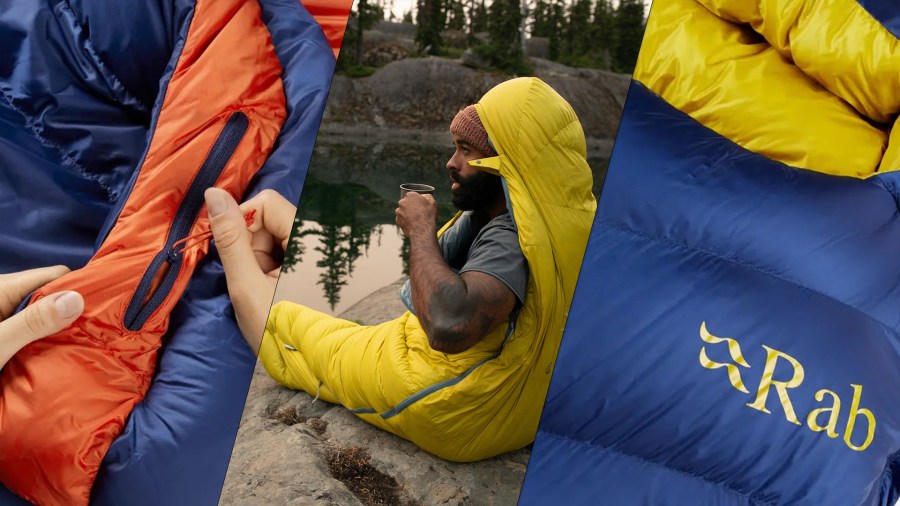
The best sleeping bags for 2024
The following list shows the best sleeping bags for men and women, all suitable for three-season camping. Each item has been extensively tested and reviewed by our expert gear team and rated for its performance, value, durability, feature set and the balance between weight and warmth.
Gruezi Biopod Downwool Subzero 185
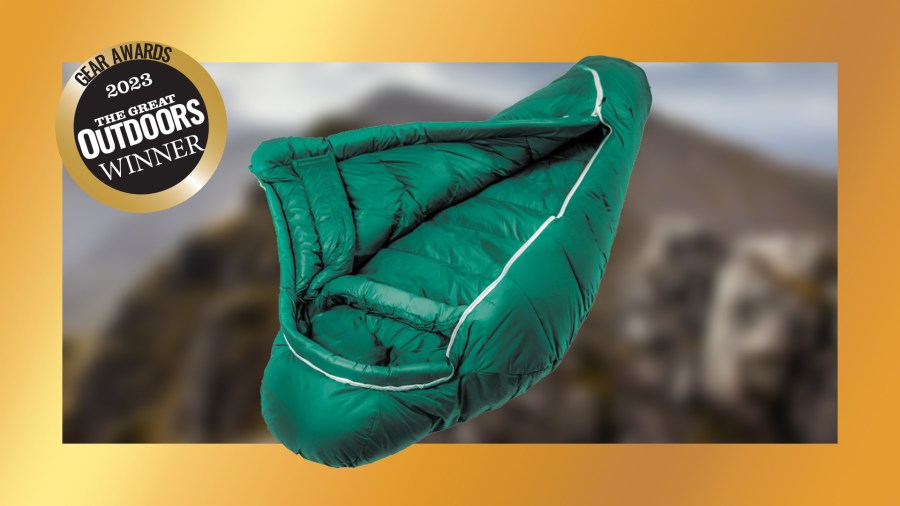
TGO Magazine verdict
In tests, it proved very comfortable, warm and not too heavy to carry – which is surprising given the wool content.- Warm when wet
- Innovative
- Comfortable
- Name is misleading
| Quick specs | |
|---|---|
| Price: €370 ( Buy now from Alpine Trek) Weight: 2.31lbs | 1050g Shell: 20 denier 380T nylon (100% polyamide) Fill: 506g DownWool of 70% duck down (90/10, 650+ cuin) and 30% wool Construction: H chambers Zip: two-way, curved, 3.4-length, whitened for night visibility Length: 215 x 80 x 50 cm (for body heights up to 185 cm) Rating: EN 23537: T Komfort: 2°C (36°F) | T Limit: -4°C (25°F) | T Extrem: -20°C (-4°F) Sizes: one size, unisex. |
This sleeping bag, which won best sleeping bag in The Great Outdoors Awards 2023, is filled with 70% duck down and 30% wool and is treated with an eco-friendly DWR. The overall weight is 1kg. Gruezi’s idea is that by adding wool to the down, it not only brings extra warmth but it also helps to draw moisture away from it, like some kind of natural dehumidifier. From our experience this really works.
In tests, it proved very comfortable, warm and not too heavy to carry – which is surprising given the wool content. The draught collar, hood and baffle construction prevented any cold spots and details like the pillow pocket, mini pocket for a headtorch or phone and the whitened zip (white makes it easier to spot at night) all proved very handy.
Therm-a-Rest Parsec 20F/-6
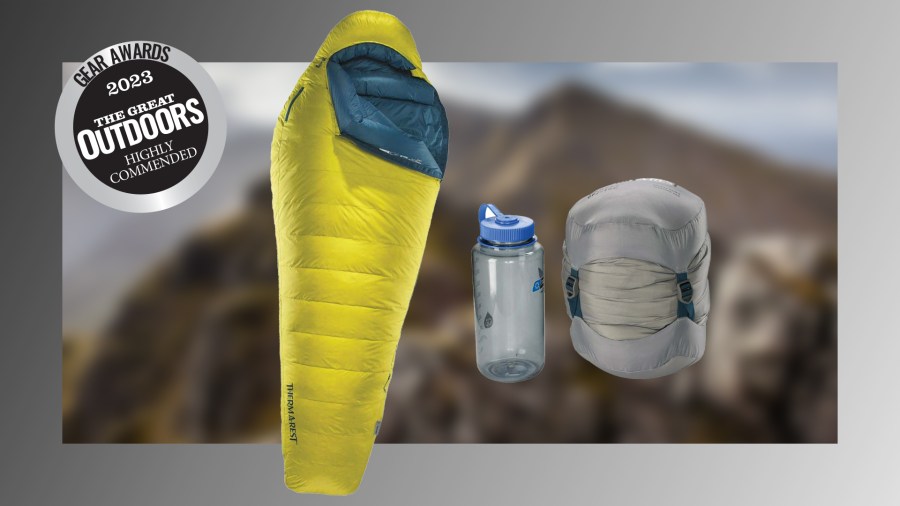
TGO Magazine verdict
Our judges in The Great Outdoors Awards agreed that theTherm-a-Rest Parsec 20F/-6 ticks all the right boxes for a sleeping bag, being “warm and comfortable, light and with some useful features- Very warm for weight
- Three sizes available
- Expensive
| Quick specs | |
|---|---|
| Price: $499 / £430 ( Buy now from Alpine Trek) Weight: 2.06lbs | 935g Fill: 470g 800FP Nikwax hydrophobic RDS down Shell: 100% recycled nylon ripstop DWR Construction: box wall Zip: ¾-length two-way YKK anti-snag Length: 80inch | 203cm (regular) Rating: comfort 0°C, limit -6°C Sizes: small, regular, long Men’s version: no, unisex |
Highly Commended in The Great Outdoors Awards 2023, the Therm-a-Rest Parsec -6 is a high-quality down sleeping bag and we tested it in some very soggy conditions. It has nice details such as a cosy pocket for feet in the bottom, a large zipped pocket on the outside, and removable straps underneath. The mummy hood is deep and luxurious, and the neck baffle isn’t adjustable. The bag is not available in men’s and women’s versions, but Therm-a-Rest produces three sizes. The regular size is generous in length (203cm) and fairly narrow (157cm girth), and a reasonable fit overall. The shell and liner are made entirely from recycled materials and filled with Responsible Down Standard down.
Our judges in The Great Outdoors Awards agreed that theTherm-a-Rest Parsec 20F/-6 ticks all the right boxes for a sleeping bag, being “warm and comfortable, light and with some useful features and materials”.
Read Lucy’s full review on the Therm-a-Rest Parsec 20F/-6
Rab Women’s Neutrino 400
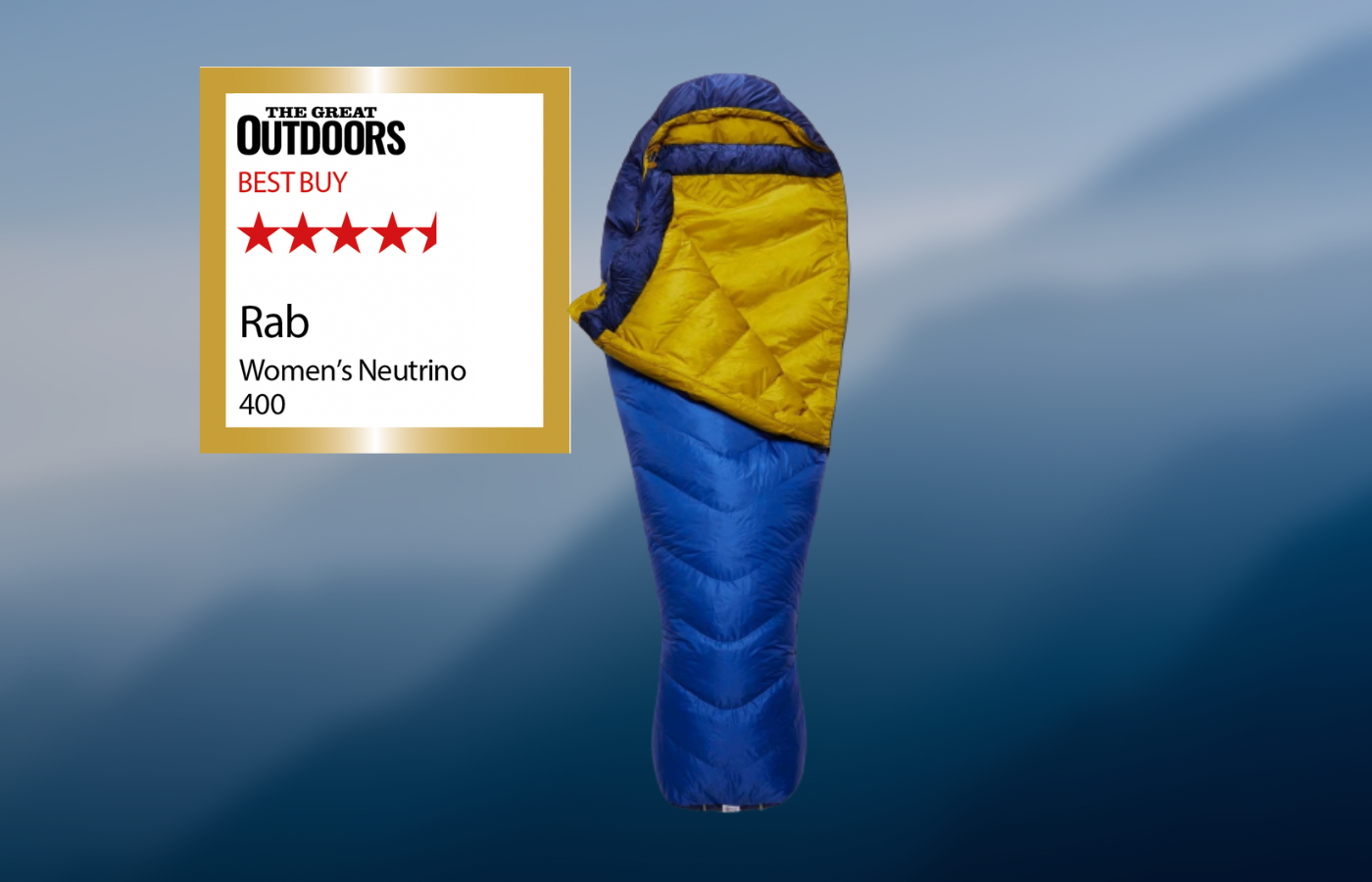
Lucy Wallace’s Best in Test
The bag is lightweight for shoulder months and winter, making it a premium choice for lightweight use. Although expensive, it is definitely worth the investment.- Light
- Warm
- Expensive
- Snug fit for taller women
| Quick specs | |
|---|---|
| Price: $400 / £400 ( Buy now from LD Mountain Centre) Weight: 1.8lbs | 849g Fill: 400g 800FP Nikwax hydrophobic RDS European goose down Shell: 20D Pertex Quantum recycled nylon ripstop Construction: trapezoidal box wall Zip: ¾-length YKK two-way anti-snag Length: 79inch | 200cm Rating: comfort -1°C, limit -7°C Sizes: one Men’s version: yes |
The Neutrino 400 sleeping bag, launched in 2022, has been updated with chevron-shaped baffles to manage down distribution and reduce weight. The drawcord system in the hood and neck baffle is improved, and the neck baffle is adjustable. The bag is smaller than the men’s version, but may be more comfortable for taller individuals. The bag is filled with European goose down certified by the Responsible Down Standard, resulting in impressive lofting capabilities. The Pertex Quantum used is made from recycled materials and is fluorocarbon-free. The bag is lightweight for shoulder months and winter, making it a premium choice for lightweight use. Although expensive, it is definitely worth the investment.
Read Lucy’s full review of the Rab Women’s Neutrino 400
Therm-a-Rest Hyperion 32F/0C
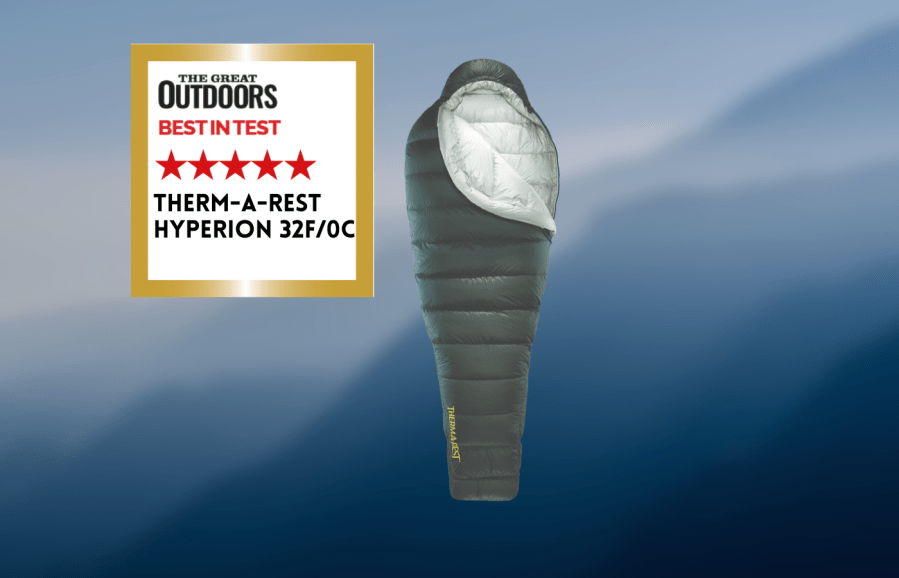
John Manning’s Best In Test
The first thing you notice about the Hyperion 32F/0C sleeping bag is the shell’s silky feel.- Weight
- Luxury fabric
- Synergy link connectors
- Left zip only
- SynergyLink Connectors
| Quick specs | |
|---|---|
| Price: £425 Weight: 528g (483g + 45g) (Regular) Fill: 900 fill Nikwax Hydrophobic Down, Responsible Down Standard-certified down Shell: 10D Nylon RipStop with DWR Construction: Box baffled construction, with zoned insulation Zip: Three-quarter zip Length: 203cm/80 inches (Regular), 216cm/85 inches (Long) Rating: Comfort 41°F/5°C, Limit 32°F/0°C Sizes: Small/Regular/Long Supplied with: Compressible stuff sack and storage bag Women/Men’s version: Unisex URL: www.thermarest.com |
The Therm-a-Rest Hyperion 32F/0C sleeping bag is a luxurious, lightweight three-season bag filled with 900-fill Nikwax Hydrophobic Down. It is comfortable-rated to 5°C and can be used down to freezing. The supplied compression sack is drawcord-closed and lacks sealed seams, making it difficult to compress. A drybag can keep the bag dry.
The bag has a longer zip for easier fit, but it is only three-quarter-length and only works for right-handed users. Therm-a-Rest has introduced “SynergyLink Connectors” to prevent slippage on the mat. The system allows the user to stay on the mat, but the bag’s narrow design prevents it from turning during sleep. However, only 30% of the bag’s insulation is in the base, making it crucial to stay on the mat. The SynergyLink Connectors are a weight-saving measure, as only 30% of the insulation is in the base.
Read John’s full Therm-a-Rest Hyperion 32F/0C Review
Exped Comfort -10°
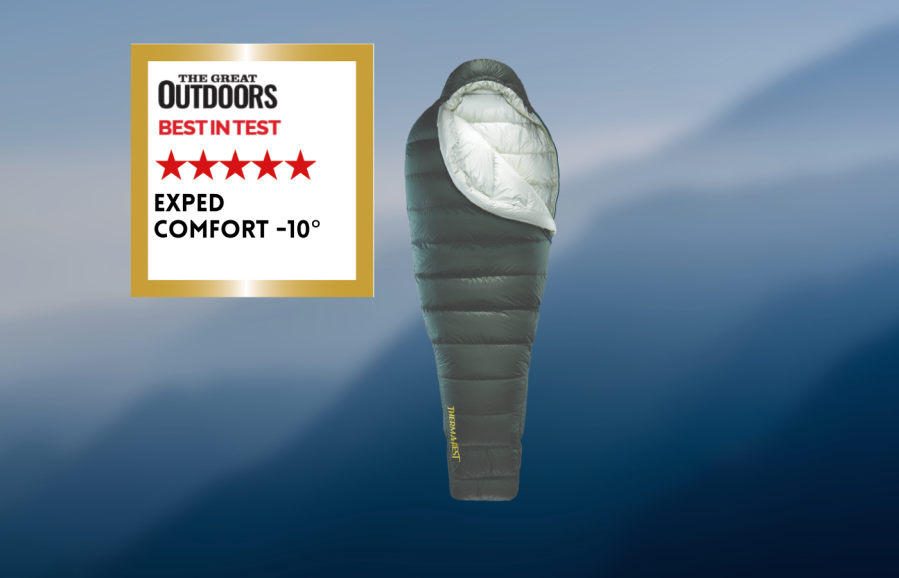
Fiona Russell’s Best in Test
This is my best in test product because while the bag is not the lightest, nor the cheapest, it offers the best balance of warmth-to-weight and great packability.- Warm
- Features
- Small pack size
- Eco Features
- Price
- Name
| Quick specs | |
|---|---|
| Price: £355 Weight: 1275g (M) Fill: 700FP RDS certified duck down Shell & lining: 20D ripstop nylon; 30D nylon, both Oeko-Tex® 100 certified, PFC-free Construction: box wall, tuck-stitch seams Zip: 2-way full length, choice of right or left Length: S: 195cm, M: 205cm Rating: comfort -4C, limit -9C Sizes: S, M Women/Mens version: Yes exped.com |
The Exped Comfort sleeping bag, a -10C women’s bag, is a luxurious and floaty option with a 615g (small size) or 675g (medium size) of 700FP down packed into stitched channels in silky soft fabric. It features a customised female design for 10 to 15% extra down insulation at the feet and torso, a 360-degree baffle at the collar, and an elastic cord closure at the hood. The bag has a mummy shape, allowing room for wriggles and a choice of right or left side for the zip. The bag also has glow-in-the-dark zip pulls and an internal zipped pocket. The bag packs into a roll-top drybag, but a stuff sack with compression straps or a larger storage sack would be better. Exped has partnered with MyClimate, a Swiss nonprofit climate protection organization, and is Oeko-Tex® 100 certified and PFC-free. The bag offers the best balance of warmth-to-weight and great packability.
Read Fiona’s full Exped Comfort -10° Women’s sleeping bag Review
Sea to Summit Ascent Acl -4
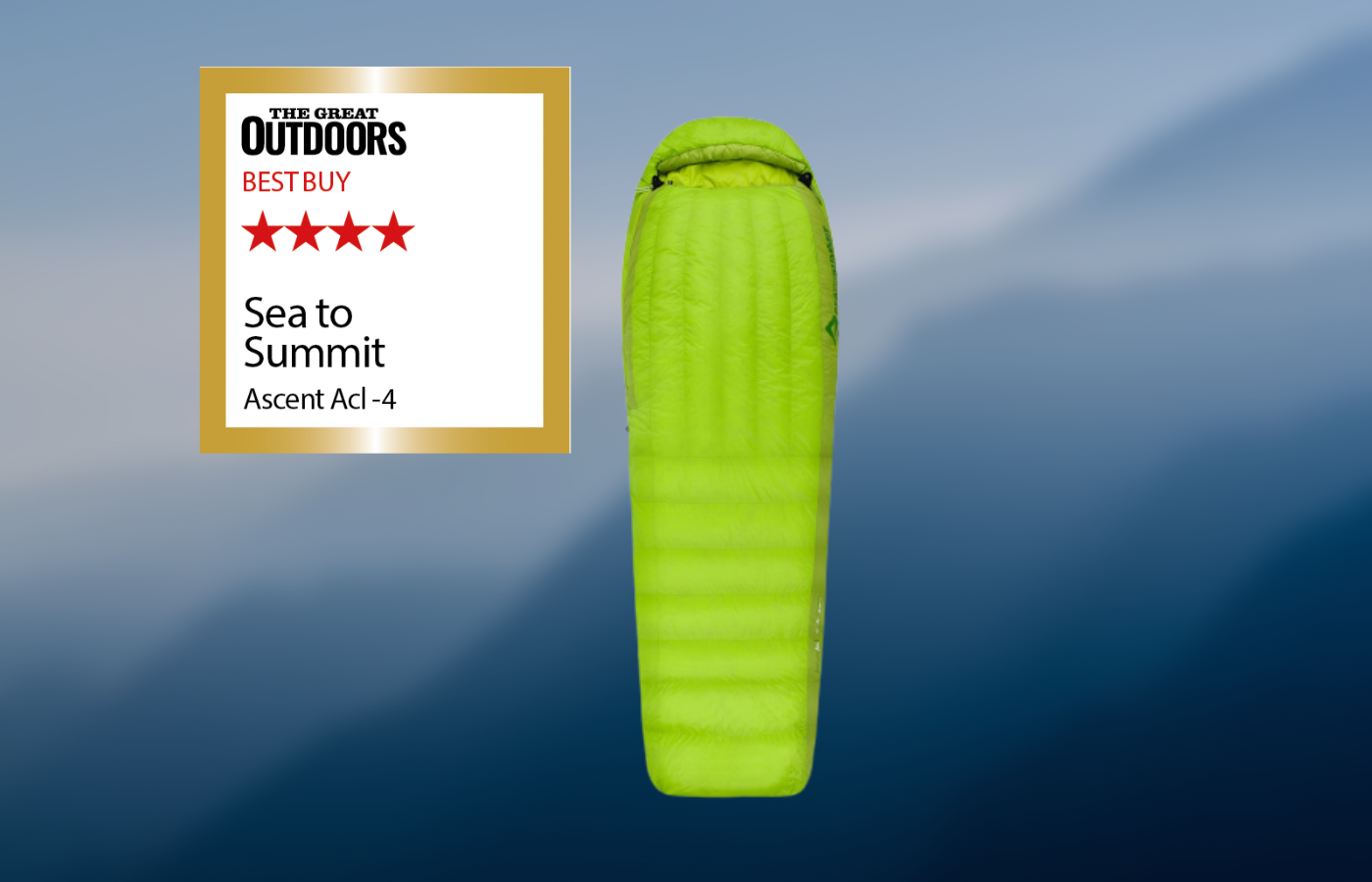
TGO Magazine verdict
Overall, the Ascent Acl-4 is a very attractive option: warm, lightweight and suitable for a wide variety of conditions.- Warm
- Packs down very small
- Hydrophobic down fill
- Expensive
| Quick specs | |
|---|---|
| Price: $399 / £320 ( Buy now from Alpine Trek) Weight: 2.04lbs | 926g Fill: 330g 750FP Ultra-Dry down Shell: 20D ripstop nylon Construction: side block baffle Zip: 2-way, full-length on left, 2-way, 1/3-length on right Length: 81inch | 205cm (regular) Rating: comfort +2°C, limit -4°C Sizes: regular, long Women’s version: no |
The Ascent is a mid-point between a mummy and a semi-rectangular bag. It has a generous lofting sack and an ultralight compression sack. It has 330g of 750 fill power Ultra-Dry hydrophobic down and Sea to Summit claims it can dry out 60% faster than untreated down. The hood is generous and can be tightened down. The bag has a zip on the right-hand side and a foot box ventilation zip, but its insulation did not extend along the length of the foot box zip. Overall, the Ascent is a very attractive option, warm, lightweight and suitable for a wide variety of conditions.
Read James Roddie’s full Sea to Summit Ascent Acl-4 review
Mountain Equipment women’s Helium 600
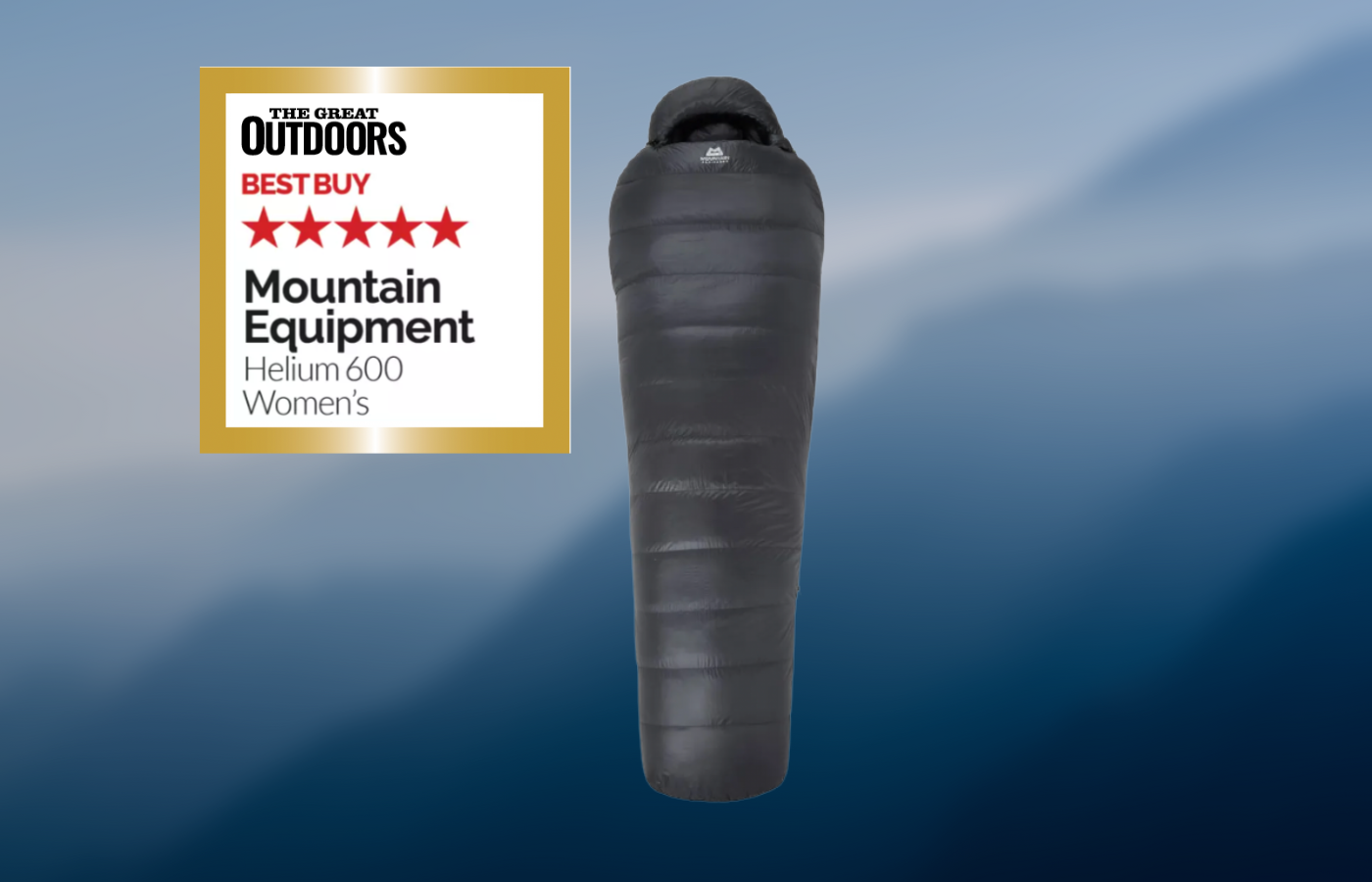
Fiona Russell’s Best in Test
The 600 is reasonably priced and lightweight but not at the expense of comfort which is why I’ve given it the Best in Test award- Warmth
- Attention to detail
- Female-Specific
- Incorrect weight
| Quick specs | |
|---|---|
| Price: $469 / £280 (Buy now from Alpine Trek) Weight: 2.23 lb. / 1012g (Long) Materials: 700 fill power 90/10 duck down; shell and lining: 100% recycled 20D nylon Temperature: ‘Good Night’s Sleep’ temperature 18°F / -8°C Features: women’s Alpine fit with zoned EXL system, slanted box-wall baffles throughout, five-baffle anatomically shaped hood, four-baffle anatomically shaped and offset foot-box, choice of regular left or right zip or left long zip, neck collar with Lode Lock closure, waterproof roll-top stuff sack, storage cube Sizes: regular (maximum user height 170cm), long (185cm) Men’s version: yes |
Mountain Equipment have made some big claims when it comes to their Helium series of sleeping bags. There are a wide abundance of features, from the choice of two lengths and zoned system that encloses the bag around your body to cut out dead air space. The 600 is reasonably priced and lightweight but not at the expense of comfort which is why we’ve given it our best buy award.
Read Fiona Russell’s full Mountain Equipment Helium 600 Women’s review.
Mammut Perform Down Bag
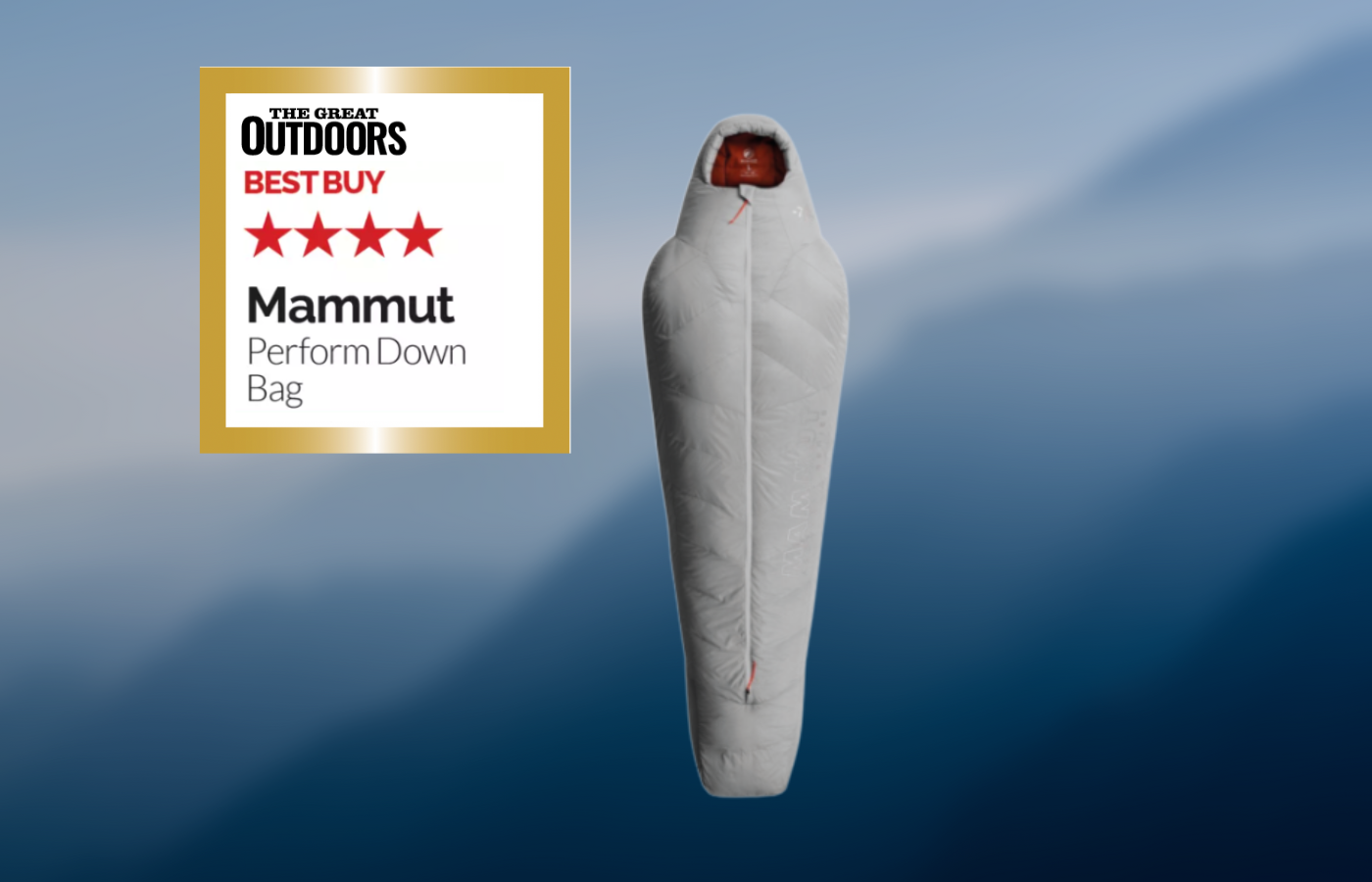
Peter Macfarlane’s Best in Test
The Mammut Perform Down Bag is warm with instant feedback on bare skin, it lofts well and the outer shell has excellent water repellency. It’s a great bag for camp and very comfortable to sleep in.- Comfort
- Performance
- Price
- Centre zip not for everyone
- Weight
| Quick specs | |
|---|---|
| Price: $400 / £355 (Buy now from Alpine Trek) Weight: 2.35 lb. / 1005g Temperature comfort limit: 19.4°F / -7°C Materials: 700 fill power ethically certificated duck down, polyester/nylon lining, nylon outer Features: box wall construction, mummy shape, full-length two way centre zip, shoulder baffle, internal pocket, stuff and storage sacks. Comes with ear plugs and sleep mask. Size: long Women’s version: unisex |
Chosen as Best Buy in a comparative review of the latest men’s sleeping bags, the Mammut Perform Down Bag comes with a different approach when compared to most other bags as it has a full length centre zip. The relaxed mummy fit allows for a good amount of movement, without there being lots of dead air space reducing efficiency. It’s very well insulated and the large internal pockets is big enough to store most items. The Mammut Perform is a brilliant bag for camping and offers a comfortable sleep.
Read Peter Macfarlane’s full Mammut Perform Down Bag review.
Rab Alpine 600
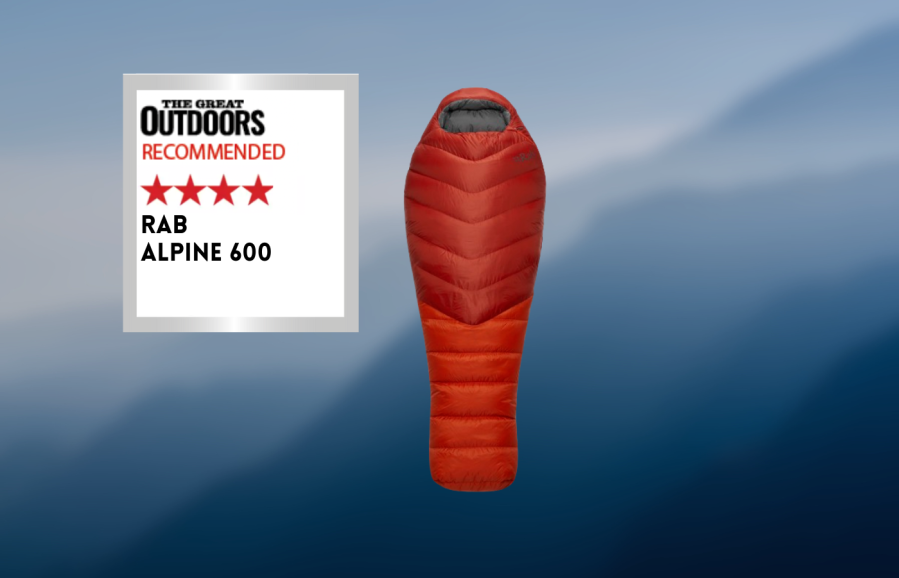
John Manning Recommends
the Alpine 600’s design is intuitive: the bag was as comfortable as it was functional, each feature easy to use and performing flawlessly.- Price
- Warm
- Made in the UK
- Intuitive
- Weight
| Quick specs | |
|---|---|
| Price: £310 Weight: 1,168g (1,132g + 36g) Fill: 600g of 650FP European duck down with Nikwax Fluorocarbon-free hydrophobic finish, Responsible Down Standard-certified down Shell: Wind-resistant 20D Pertex Quantum nylon ripstop (36gsm); Lining: 20D nylon (38gsm) Pertex Quantum outer with recycled nylon lining Construction: Trapezoid boxwall baffle with differential cut, with chevron baffle on upper torso Zip: Two-way YKK three-quarter length main zip with anti-snag zip insert Length: 215cm/84.6 inches (Regular); 230cm/90.6 inches (Long) Rating: -9°C/15°F Sizes: Regular/Long Supplied with: Stuff sack (unsealed seams) and storage bag Women/Men’s version: both URL: rab.equipment |
The Rab Alpine 600 sleeping bag is a top choice for backpackers, with its intuitive design and functional features. The bag is designed to be snug around the torso but roomy from the thighs down, with 600g of 650FP duck down fill held in chevron-patterned baffles to reduce down migration and maximize heat retention. The shell is made from wind-resistant Pertex Quantum and the lining is 100% recycled 20D nylon. The down-filled collar and hood drawcords are effective in retaining warmth.
The bag’s main zip has a draught-excluding baffle and anti-snag tech, and a zipped internal pocket at the chin is useful for phone storage. The Rab Alpine 600 is rated for three-season use, with a sleep limit of -9°C, but the EN Temperature rating is -5°C, with an extreme limit of -12°C. The bag weighs 1.132kg, making it heavier than some may prefer for summer fells.
Read John’s full Rab Alpine 600 Review
Nemo Forte Women’s 35
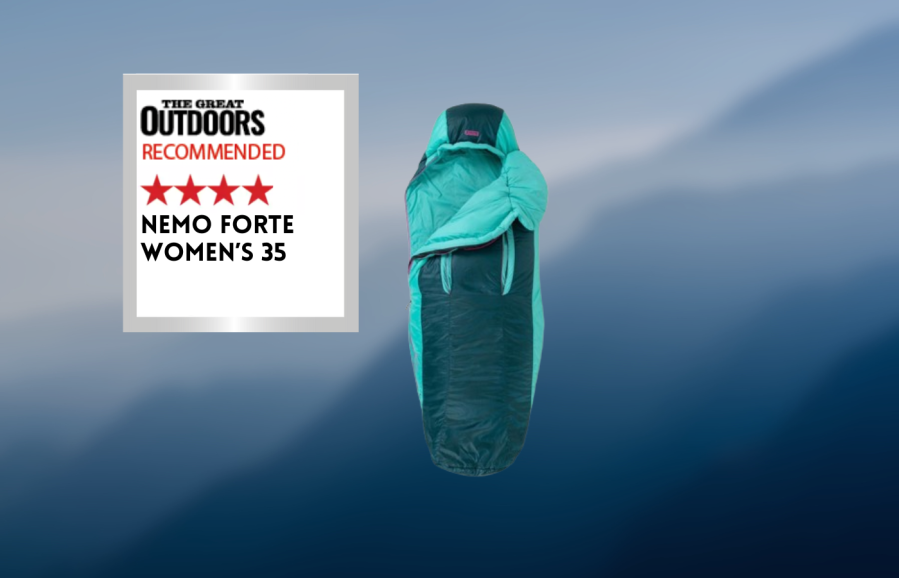
Fiona Russell’s Recommended
Overall, I slept really well in this bag and because it is a three-seasons bag at a price of under £200, I am recommending it for people with a tighter budget.- Price
- Compression bag
- Eco Features
- Weight
- Zip
| Quick specs | |
|---|---|
| Price: £179.99 reg, £199.99 long Weight: 1350g (reg) Fill: 800g Zerofiber™ PCR synthetic (100% post-consumer recycled content) Shell: 30D 100% recycled polyester, Bluesign approved ripstop; Lining: 20D 100% recycled polyester taffeta Construction: box wall, stitch through Zip: full-length, two-way Length: 185cm (reg), 198cm (long) Rating: comfort 2C , limit 0C Sizes: reg, long Women/Mens version: Yes URL: nemoequipment.com |
The Nemo Forte is a heaviest synthetic sleeping bag, providing warmth even in damp conditions. It features a compression stuff bag and a large mesh storage bag, providing good warmth in night-time temperatures above 2C/3C. The bag has two Thermo Gill™ vents for greater temperature control. The Blanket Fold™ draught collar is fine, but an integrated full-circumference baffle is preferred. The integrated pillow pocket is excellent for storing spare clothes or an inflated pillow. The inner fabric is silky, but the outer fabric is noisy. Nemo’s Classic Spoon™ shape offers ample space for sleeping, but the full-length side zip is snaggy. The Forte is part of Nemo’s more planet-friendly Endless Promise range, which includes products being repairable, resaleable, and recyclable at the end of life. The bag is recommended for people with a tighter budget and is a three-seasons bag priced under £200.
Read Fiona’s full Nemo Forte Women’s 35 Review
Mountain Equipment Firelite
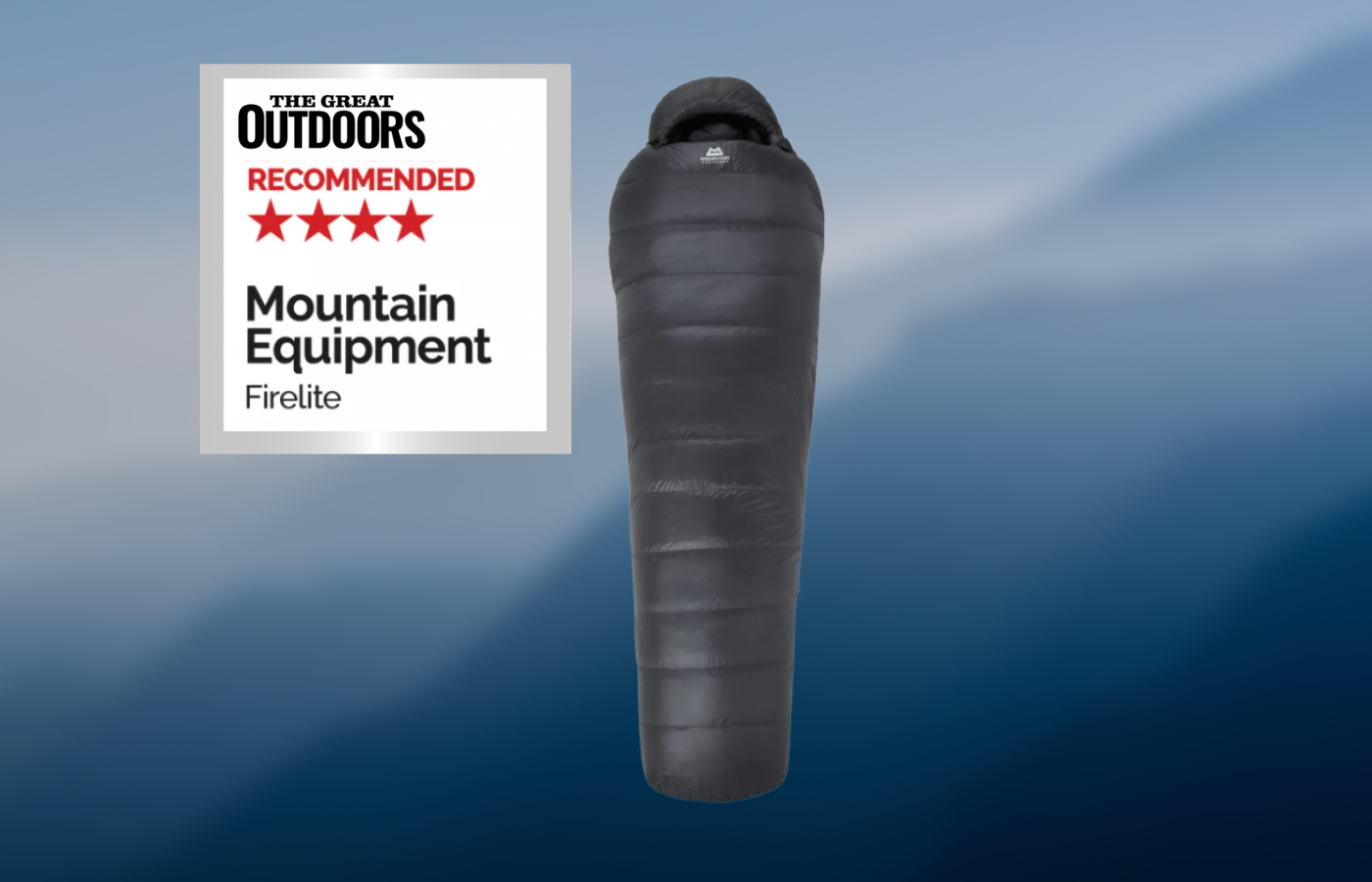
Peter Macfarlane Recommends
It maintains great performance at a low weight by using very high-quality down and a very light shell fabric.- Weight
- comfort
- Performance
- Price
| Quick specs | |
|---|---|
| Price: $700 / £500 (Buy now from Alpine Trek) Weight: 1.68 lb. / 764g (Regular) Materials: 900 fill power ethically certificated goose down, nylon shell Temperature comfort limit: 16°F / – 9°C Features: slant box wall construction, mummy shape, stretch seams, full-length two-way zip, shoulder baffle, stuff sack and storage sack Sizes: regular, long Women’s version: yes |
The Firelite is one of the lightest bags in this review, but it maintains a strong performance with very high quality down and light shell fabric. The weight of the bag means it’s great for longer hikes and high camps outside of winter. However all of this comes at a cost with it being the most expensive within the best mens sleeping bags test.
Read Peter Macfarlane’s full Mountain Equipment Firelite review.
Sierra Designs Women’s Night Cap 20
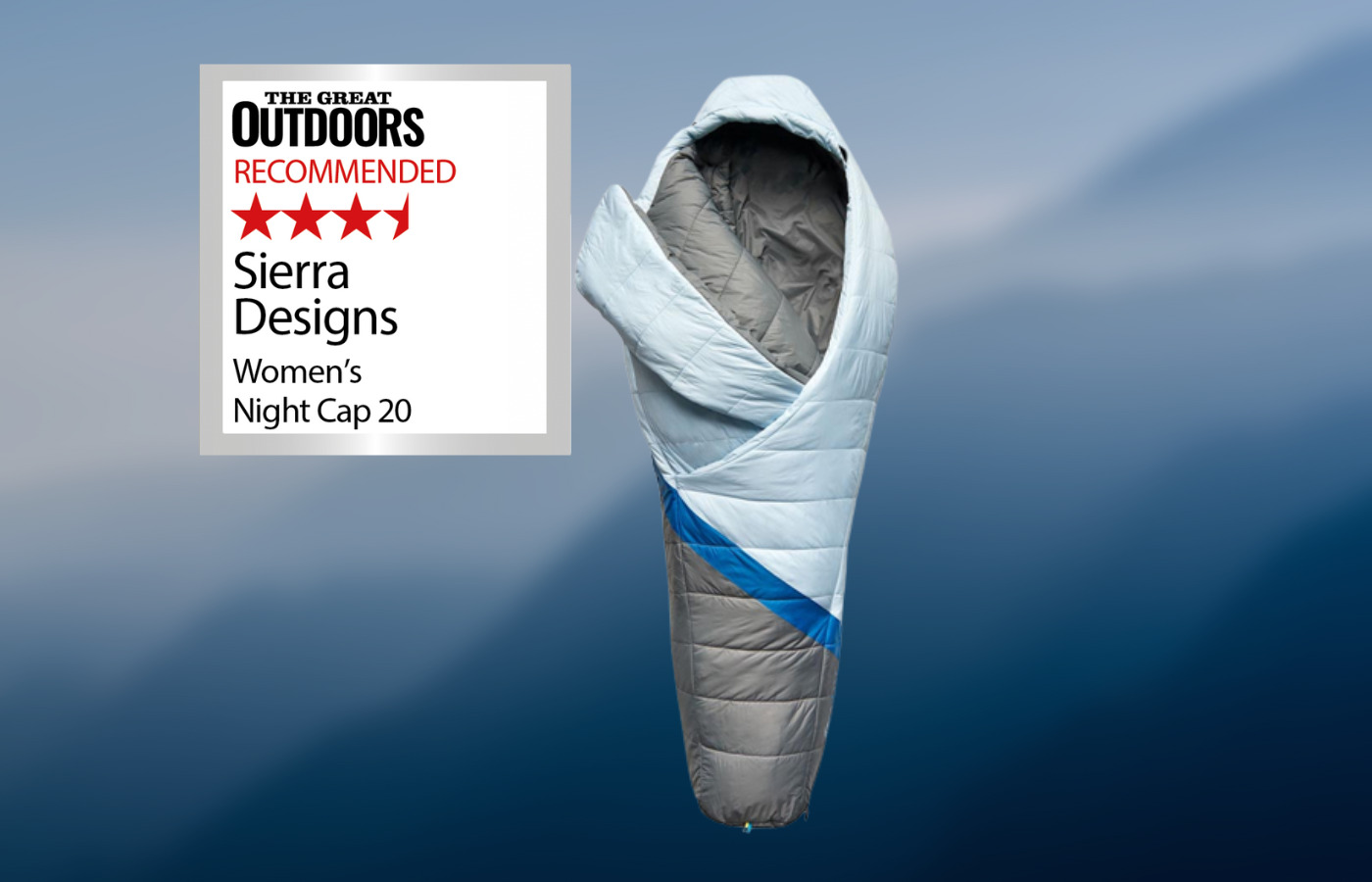
Lucy Wallace Recommends
Overall, it’s clever and warm, with a smaller environmental footprint than many other synthetic bags; and although it won’t suit everybody, some will love the versatile comforter system.- Versatile
- Good for warm sleepers
- Zipless design can lead to draughts
| Quick specs | |
|---|---|
| Price: $180 / £160 (Buy now from Amazon) Weight: 3.5lbs | 1626g Fill: 1276g recycled Sierraloft Eco Synthetic Shell: 20D recycled polyester Construction: synthetic fill Zip: none Length: 74inch | 188cm Rating: comfort +1°C, limit -5°C Sizes: one Men’s version: yes |
Sierra Designs has pioneered innovative zipless bag designs, such as the Nightcap 20. The wrapover shape creates versatility for warm sleepers who like to vent through the night and allows for spreading out a bit if needed. The drawback is that it can fall open with too much movement, leading to draughts. The bag includes a sleeping mat sleeve on the base and a neck baffle, and the Eco Synthetic fill is made from recycled water bottles and the shell is recycled. Overall, it is clever and warm, with a smaller environmental footprint than many other synthetic bags, and some will love the versatile comforter system.
Read Lucy’s full review on Sierra Designs Women’s NightCap 20
Robens Icefall Pro 900
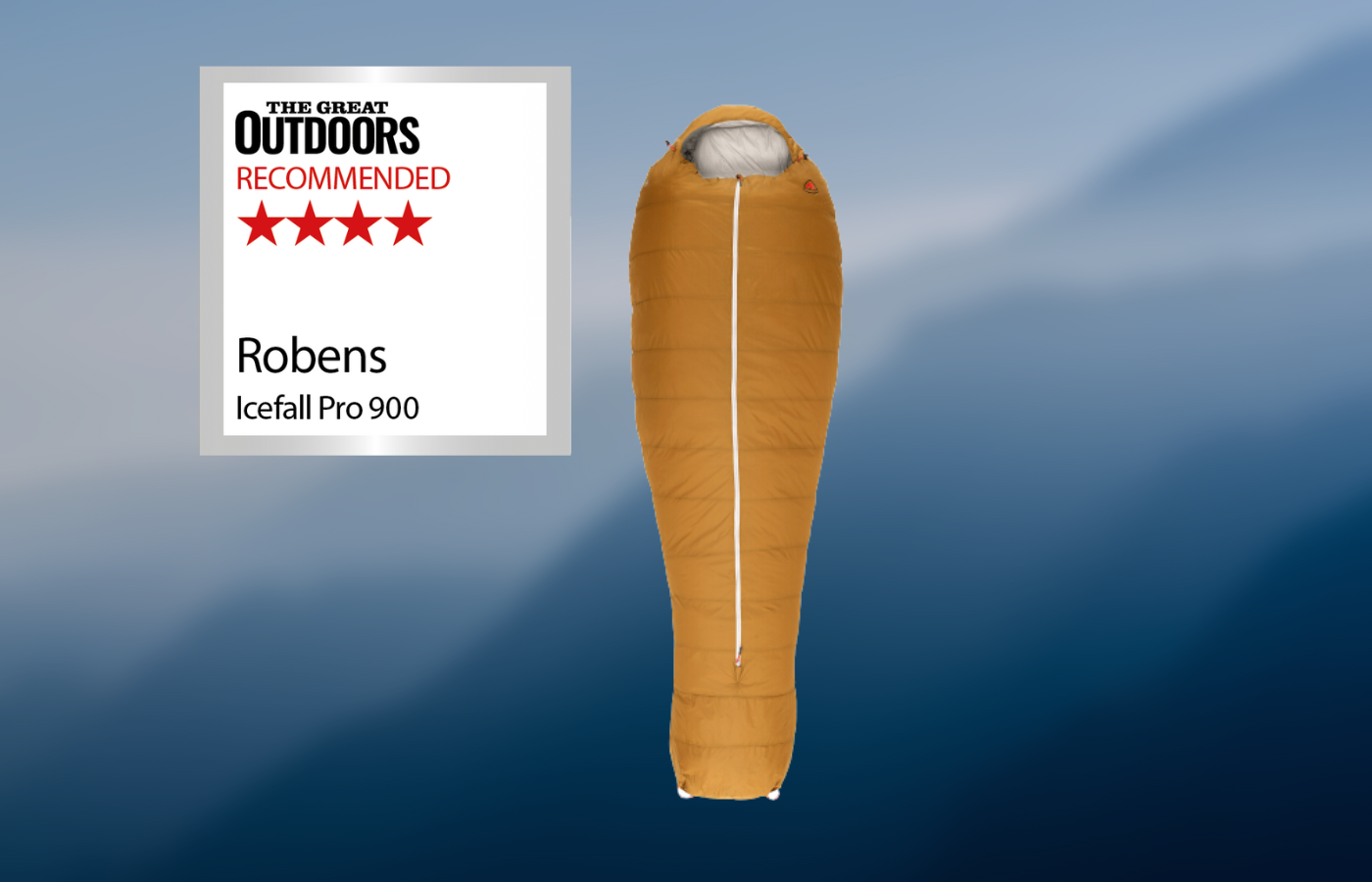
James Roddie Recommends
Whilst quite heavy and lacking a shorter version, the Icefall Pro 900 is a well-designed sleeping bag, particularly if you prioritize warmth and comfort.- Very warm
- Comfy
- Versatile centre zip
- Heavy
- Long with no short option
| Quick specs | |
|---|---|
| Price: $200 / £190 (Buy now from Amazon) Weight: 3.2lbs | 1495g Fill: 900g MicroThermo Ball 600FP polyester Shell: 20D ripstop nylon Construction: box wall Zip: 2-way, near-full-length in centre Length: 87inch | 220cm Rating: comfort 0°C, limit -5°C Sizes: long Women’s version: no |
The Icefall Pro 900 is the warmest sleeping bag in this review due to its 900g MicroThermo Ball synthetic insulation. It is aimed at taller people and has a high waist drawcord to keep the warmth in. It has a zip in the centre of the bag, which makes getting in and out of the bag much easier and allows for even ventilation over the core. There is no side ventilation zip, but it is easy to undo the zip almost to the feet and use the bag like a quilt in warmer conditions. Whilst quite heavy and lacking a shorter version, the Icefall Pro 900 is a well-designed sleeping bag, particularly if you prioritize warmth and comfort.
Read James Roddie’s full review on Robens Icefall Pro 900
Kelty Women’s Cosmic Synthetic 20
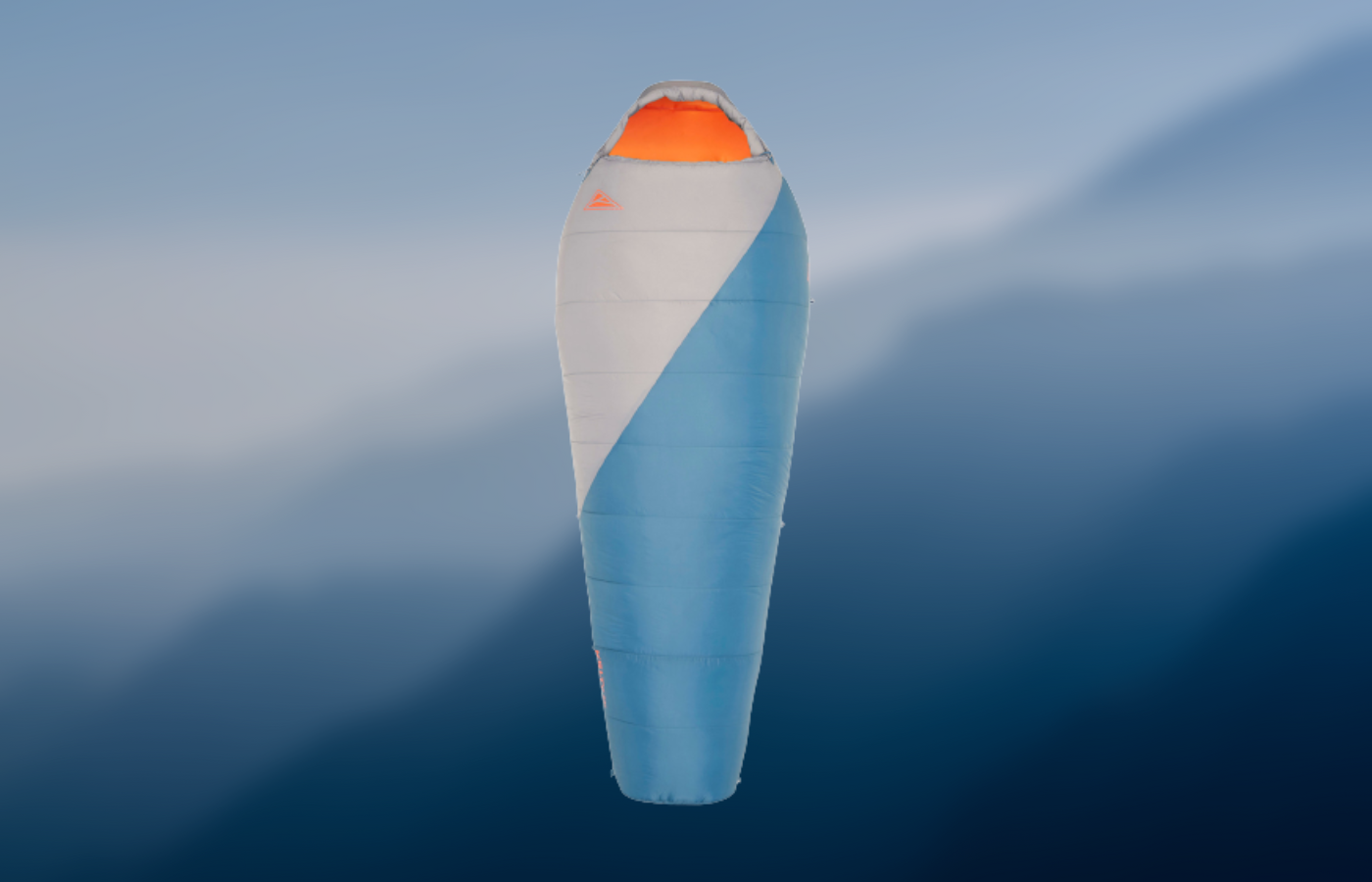
Lucy Wallace’s verdict
Despite drawbacks, the Cosmic 20 synthetic sleeping bag is a great choice for those seeking warmth and affordability in their hiking gear.- Good value
- Warm
- Heavy
- Not very compressible
| Quick specs | |
|---|---|
| Price: $110 / £90 Weight: 4.1lbs | 1856g Fill: 1300g CirroLoft Shell: 380T nylon taffeta Construction: synthetic fill Zip: Kelty’s own brand ¾-length two-way Length: 74inch | 188cm Rating: comfort -4°C, limit -11°C Sizes: one Men’s version: yes |
The Cosmic 20 synthetic sleeping bag is a great value for warmth and affordability, offering a comfort rating of -4°C. It weighs 1856g, has a 1300g CirroLoft fill, and is made of 380T nylon taffeta shell. The bag features non-adjustable neck baffles and a drawcord for heat retention. It is suitable for people up to 172cm tall and has a wide footbox for side sleepers. The bag is heavy at 1856g but has an advertised weight of 1810g. However, the CirroLoft synthetic fibers feel stiff and bulky, resulting in lack of compressibility. The minimum pack size is 41x25cm, making it best suited for car camping. Despite these drawbacks, the Cosmic 20 synthetic sleeping bag is a great choice for those seeking warmth and affordability in their hiking gear.
Read Lucy’s full review on Kelty Women’s Cosmic Synthetic 20
Nordisk Oscar -2° Curve
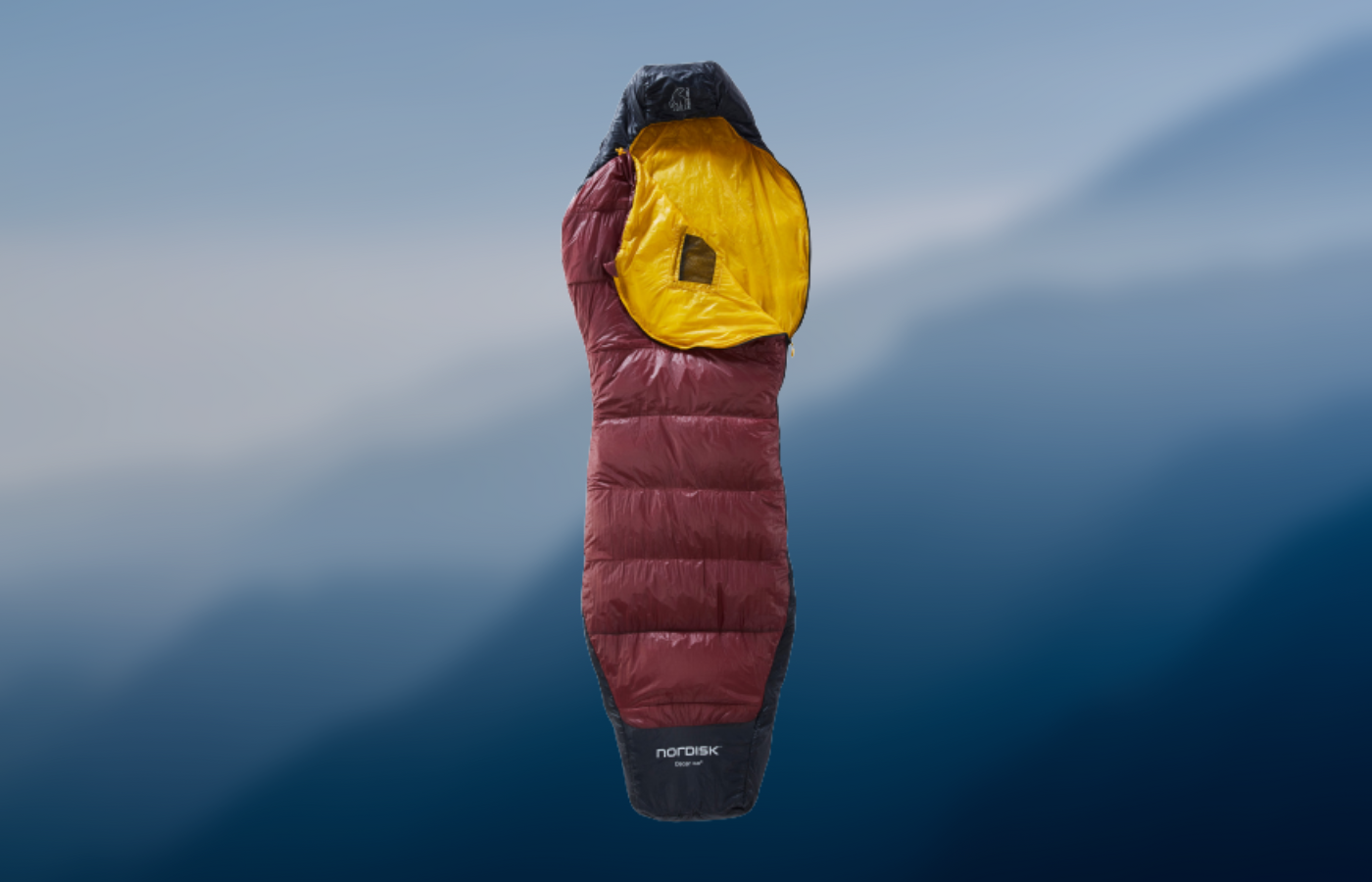
James Roddie’s verdict
The Oscar -2° Curve is a good option for three-season backpacking when size and weight are crucial considerations.- Lightweight
- Small when packed away
- 00% recycled synthetic filling made from recycled PET bottles
- Expensive
- Zip pulls small and fiddly
| Quick specs | |
|---|---|
| Price: International shipping / £296 (Buy now from Alpine Trek) Weight: 2.07lbs | 940g Fill: NorGuard S-PO s-core fibre Shell: 7D ripstop nylon Construction: offset double box wall Zip: 2-way, 3/4-length on left Length: 81inch | 205cm (large) Rating: comfort +4°C, limit -2°C Sizes: medium, large, extra-large Women’s version: no |
The Oscar -2° Curve is a lightweight and very packable sleeping bag. It is supplied with two different carry sacks, a dry-sack and an extremely lightweight bag made from the same ripstop nylon as the sleeping bag shell and lining. The shell and lining material feels soft, comfortable and very thin. The ‘curve’ shape of the bag is described by Nordisk as ‘the optimal balance between insulation and space’. The bag includes ventilation zips on both the right shoulder and foot box.
The hood and draught collar are both easily adjusted, and the head felt nicely insulated on cold nights. It tested down to temperatures of +4°, and while other sleeping bags felt warmer in comparable conditions, the Oscar -2° Curve is a good option for three-season backpacking when size and weight are crucial considerations.
Read James Roddie’s full review on the Nordisk Oscar -2° Curve
Deuter Orbit -5
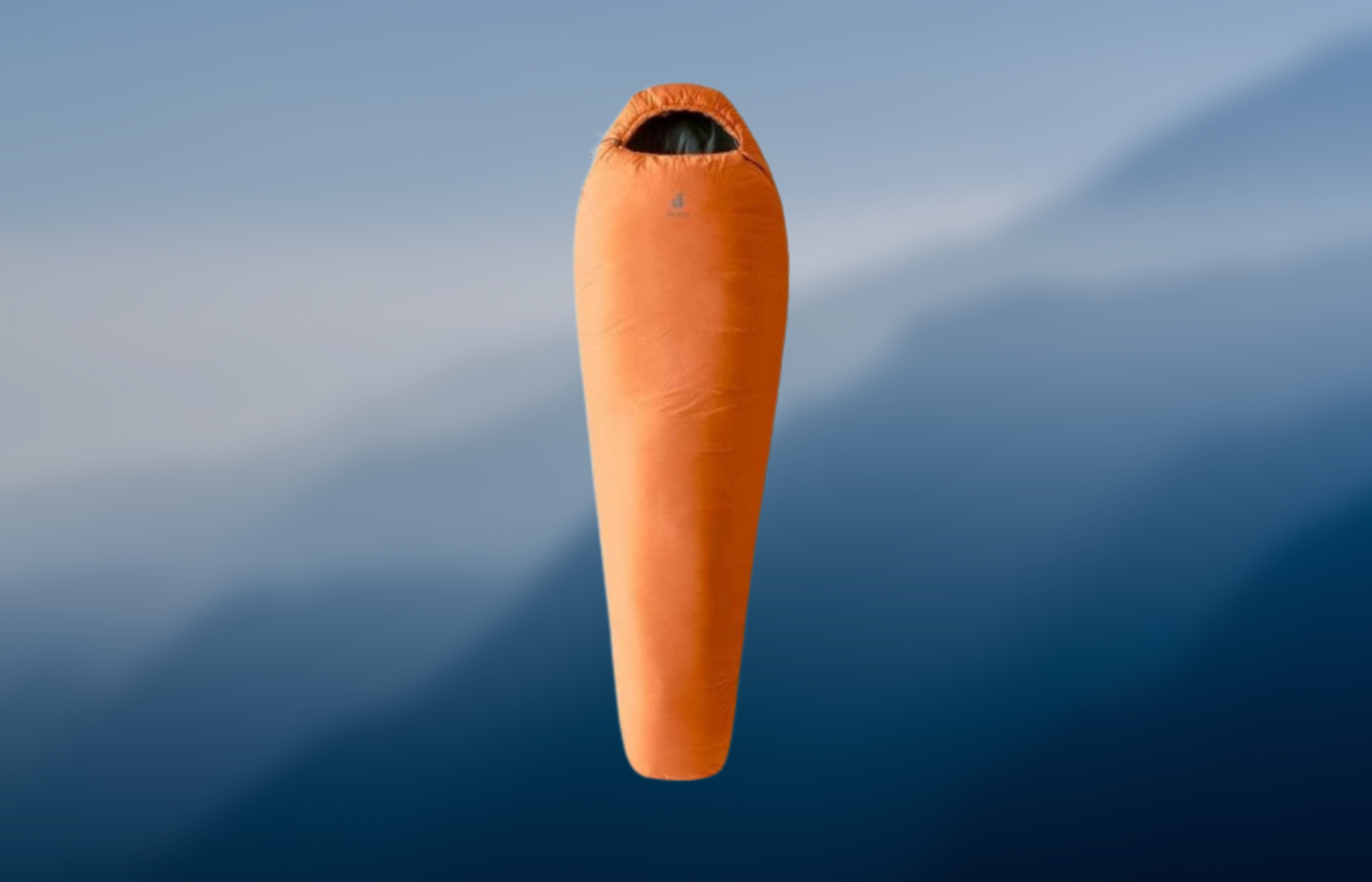
James Roddie’s verdict
For general three-season camping, this is a warm and affordable sleeping bag, but it is large and heavy, and if carrying it whilst backpacking you will notice the weight quickly.- Warm
- Affordable
- Durable
- Heavy
- Large when packed away
| Quick specs | |
|---|---|
| Price: International shipping / £115 Weight: 4.03lbs | 1830g Fill: 900g high-loft hollowfibre Shell: 50D Rec Pes ripstop Construction: 2-layer Zip: 2-way, full-length on left |Length: 81inch | 205cm (regular) Rating: comfort +1°C, limit -5°C Sizes: regular, large Women version: yes |
The Deuter Orbit -5° is a warm, affordable sleeping bag that is not aimed at lightweight backpackers. It is large and heavy, but it is well-insulated and has a thick baffle and draught collar to keep warm air in. The hood is warm, but it does not extend over the top/front of the head as much as it would like. The main two-way zip features a large pull, making it easy to find and use during the night. The anti-snag zip guard is an effective feature, as snagging zips is a common annoyance with sleeping bags. For general three-season camping, this is a warm and affordable sleeping bag, but it is large and heavy, and if carrying it whilst backpacking you will notice the weight quickly.
Read James Roddie’s full review on the Deuter Orbit -5
How we tested the sleeping bags
Fiona is a US size 8 (UK 10) and is 5 foot 6 tall. She is a cold sleeper. She walked and wild camped with the bags (and used the same inflatable sleeping mat) in the mountains and glens of the Scottish Highlands. To test the DWR (durable water repellent), she poured on water and applied a little pressure and movement. The product weights are taken from Fiona’s own digital scales.
Peter Macfarlane slept in the bags in the same woodland bothy and using the same sleep mat to achieve some consistency in judging the overall performance. Peter is six feet tall with a 44” chest and comments on fit are based on his sizing. Peter tested for water resistance to spills and condensation by applying clean water and light pressure. Weights are from his scales.
Lucy Wallace is 171cm tall with narrow shoulders. She sleeps cold, so likes a warm bag. Her bags were tested in winter and spring conditions in Scotland and the Lakes, both wild camping and in a campervan. Weights including stuff sack were measured on Lucy’s digital scales.
James Roddie is 180cm tall with average-width shoulders. He tends to be a ‘cold sleeper’, and he has taken this into consideration. He tested the sleeping bags in a variety of conditions in the Scottish Highlands during the spring – in overnight temperatures ranging from around +2°C to +9°C. He weighed the sleeping bags (including stuff sacks) using his own digital scales.
John Manning is 5’7” tall, wears XL sized clothing and generally sleeps warm. He tested the bags in the Three Peaks area of the Yorkshire Dales. Weights for sleeping bags and stuff sacks were taken on his digital scales; minor disparities between weights of individual items and weights of combined items are attributable to the scales’ slight intolerances. Durable Water Repellent coatings were tested under a tap.
Related content
What makes the best sleeping bag for you?
1. Insulation: down versus synthetic
Sleeping bags use either down or synthetic insulation. Down fill is lighter and warmer for its weight and packs smaller, but loses performance when wet.
It comes in different qualities and fill weights, which affects performance and price. Synthetic fill is less compressible for packing but retains performance when wet.
2. Temperature ratings
In addition to the brands’ own temperature usage recommendations, it’s always worth checking sleeping bag temperature ratings. These are Comfort, Comfort Limit and Extreme.
Comfort indicates a temperature where you can expect a good undisturbed sleep; Comfort Limit is as low as you can expect a decent night’s sleep; and Extreme indicates the temperature where the bag should keep you safe but not comfortable enough for a night’s sleep.
3. Construction
A down bag’s performance comes from its ability to allow the fill to ‘loft’ – to expand fully – trapping as much air as possible to retain body heat. Box wall construction aims to maintain an even density of insulation around your body but adds bulk and manufacturing expense; stitch-through construction is lighter and cheaper but allows cold spots.
4. Entry
Sleeping bags’ entry options range from full-length zips to half zips to no zips at all. Longer zips give easier access and let you cool off; shorter zips can get you a smaller pack size; zipless bags can be tricky to get into in small tents.
Main zips should have baffles to prevent heat loss.
5. Hood
Hoods vary greatly in style but can be vital on colder camps. The most basic are lightly insulated with a simple drawstring around your face whilst some are fully insulated and formed to give maximum protection.
6. Shoulder baffle
There is often an internal baffle that can be tightened around your shoulders to trap the warm air inside the bag. Easy adjustment of this feature is important.
7. Sleeping bag Fit
Most bags have a tapered ‘mummy’ shape, being widest at the shoulders and narrowing down to the foot.
Female and male bag designs account for different body shapes, and improves thermal efficiency by removing dead space. The amount of taper varies and can affect user comfort depending on your natural sleep position.
8. Footbox
Good footboxes are shaped to accommodate your feet whilst allowing insulation to fully loft to maintain warmth.
9. Pack size & weight
In the hills a compact, lighter bag will make life easier; for campsite use a heavier, bulkier bag may be less of an issue.
10. Additional sleeping bag features
Some bags have pockets, useful for keeping camera batteries warm or stashing a headtorch where it’s handy.

